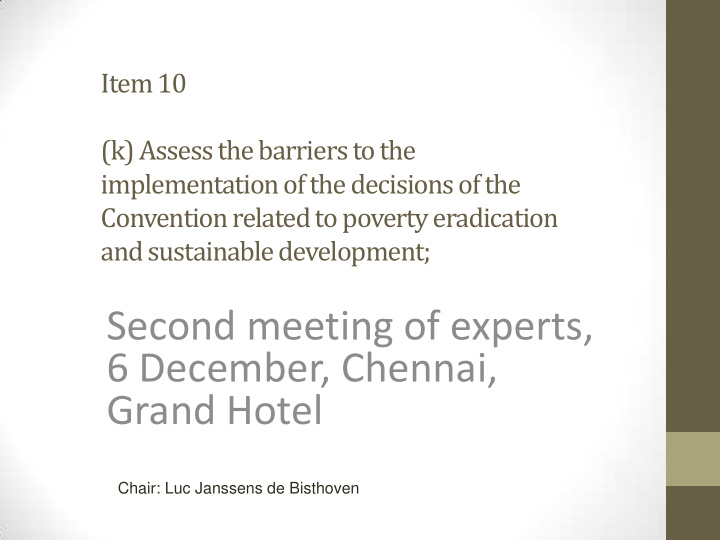



Item 10 (k) Assess the barriers to the implementation of the decisions of the Convention related to poverty eradication and sustainable development; Second meeting of experts, 6 December, Chennai, Grand Hotel Chair: Luc Janssens de Bisthoven
Preparatory document (1) Item 10 1. In paragraph 4(k) of the annex to decision XI/22 on biodiversity for poverty eradication and development, the Conference of the Parties requested the Expert Group on Biodiversity for Poverty Eradication and Development to “Assess the barriers to the implementation of the decisions of the Convention related to poverty eradication and sustainable development”. 2
Preparatory document (2) 2. The COP 10 and COP 11 decisions related to poverty eradication and sustainable development are included in this document as Annex 1 and Annex 2 respectively. Decisions are numerous and concern different topics or programmes of work. Barriers to implementation of these decisions depend certainly on the topics or issues in question and the contexts of implementation . The Expert Group would review these barriers and identify which one of them could be considered as priority or strategic and provide some proposals or recommendations to help pave 3 the pathway to overcome these barriers.
Preparatory document (3) 3. This work will start with a brainstorming session where the experts will identify the barriers they deem most important using the list of decisions provided in the annexes. Then the experts will discuss and agree on the priority barriers to overcome. 4
Preparatory document (4) 4. The Expert Group may wish to consider the following ideas for possible inclusion in new recommendations and/or guidance for implementation Some elements among the following could guide recommendations on overcoming barriers to implementation of the decisions on poverty eradication and sustainable development in order to 1.provide more practical guidance and/or tools , 2.introduce new methods/approaches , 3. raise awareness on the need, 4.produce evidence to make the case to key stakeholders who may not be convinced, 5.assist in the process of mainstreaming in various policy fields, 6. enhance the capacity of policy makers or other stakeholders, 5 7. identify alternative funding sources and mechanisms.
Constraints • TIME: 1 hour and 15 minutes (after this intro)=75 min. • LONG LIST OF (preselected by SCBD) DECISIONS related to development to REVIEW: • 17 pages • COP 10: 15 decisions • COP11: 12 decisions ! But also: 6 • Rio+20 (>200 articles, summarized on 2 A4)
Methodology • Top-down: from list of decisions to barriers to solutions (proposed) • Advantage: close to COP 10 and 11 • Disadvantage: difficult to be participative process, creativity impeded, linear, fragmented • Bottom-up: from brainstorming to problems to solutions to matching with COP 10 and 11 (ideally) • Advantage: creative, participative, less linear • Disadvantage: time-consuming, less control, needs strategy, reality check for COP 10 and 11 and RIO+20 • Tends to re-invent the wheel • How to overcome? Hybrid solution with parrallel working 7 groups or world café (rotating)
Today’s process (item 10) 3x 25 min. List of COP 10 and COP 11 decisions 3TABLES/3 colours! WORLD CAFÉ (8 min. x 3 tables= 25 minutes) Per TABLE: Which barriers? which problems? brainstorming with colour cards Reporting of the TABLES in plenary : 25 min. Cluster the cards on flip charts prioritize Per flip chart: which solutions? 25 min. translate into positive statements by the WGRI panel Recommendations to overcome the barriers to the implementation of COP, 8 Aichi targets and RIO+20 by the WGRI panel?
From barriers to solutions - Translation of the problems (negative) to objectives (positive) Verification of the hierarchy of the objectives Visualisation of the cause-effect relations in the form of a diagram (objective tree) deciding what is more important (priorities) 9 Deciding what is feasible (strategy)
Associating the Aichi targets (GOALS) per table ensures reality check; however it is NOT 1 to 1; some decisions apply to several goals Working Table 1 1- RED: Strategic Goal A: Address the underlying causes of biodiversity loss by mainstreaming biodiversity across government and society Decisions: X/2, X/6, X/10, X/17, X/22 XI/6, XI/7, XI/9, XI/22 Rapporteur: 10
Working table 2 2- BLUE: Strategic Goal B: Reduce the direct pressures on biodiversity and promote sustainable use Strategic Goal C: To improve the status of biodiversity by safeguarding ecosystems, species and genetic diversity Decisions: X/28, X/29, X/30; X/31, X/33 XI/15, XI/16, XI/18, XI/23, XI/25 Rapporteur: 11
Working table 3 3- GREEN: • Strategic Goal D: Enhance the benefits to all from biodiversity and ecosystem services Strategic Goal E: Enhance implementation through participatory planning, knowledge management and capacity building Decisions: X/1, X/3, X/6, X/23, X24, X/25, X/28, X/30, X/31, XI/3, XI/5, XI/6, XI/8 Rapporteur: 12
Outcome of this session Working table Barriers Priorities Solutions (problems) (strategy) (objectives) 1 (goal A) 2 (goals B & C) 3 (goals D & E) 13 Recommendations
Recommend
More recommend